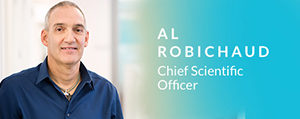 When Al Robichaud got his start as a medicinal chemist in 1991, he knew that discovering and developing drugs meant shouldering some level of risk.
When Al Robichaud got his start as a medicinal chemist in 1991, he knew that discovering and developing drugs meant shouldering some level of risk.
But around 2011, it became clear that the process for developing brain drugs was too costly and risky for major pharmaceutical companies to justify pursuing, as companies including Novartis (NYSE:NVS), GlaxoSmithKline (NYSE:GSK), Pfizer (NYSE:PFE) and Sanofi (NYSE:SNY) significantly downsized their neuroscience units.
Robichaud couldn’t shake the feeling that the industry was on the verge of walking away from what is at the very core of drug discovery.
“There was an incredible opportunity in neuroscience. But most of the big companies were running away from neuroscience at the time,” he told Drug Delivery Business News. “We’re discovering things that don’t currently exist on this planet. And to do that you have to take some risk.”
Now CSO at Cambridge, Mass.-based biotech Sage Therapeutics (NSDQ:SAGE), Robichaud noted that some bigger companies are getting back into developing drugs for the brain.
“Maybe they’re changing the way they think based upon some of the results that companies like Sage and others have had. But I spent 21 years in large pharma before I joined Sage and I don’t know that I could have done at large pharma in 21 years what we’ve done at Sage in the last six and a half,” Robichaud told us.
At a time when large pharmaceutical companies were walking away from CNS drugs, the team at Sage Therapeutics dug in. In recent years, they’ve centered their efforts around an intravenous drug designed for women with postpartum depression.
The product, which Sage calls brexanolone, is a compound that occurs naturally in the human body as a metabolite of progesterone. Through years of study, Sage’s team of scientists discovered that brexanolone modulates the activity of a neurotransmitter called gamma-Aminobutyric acid, or GABA, and its receptors.
GABA helps to calm the brain by binding to its receptors and slowing down nerve activity, Robichaud explained.
 Sage’s co-founder, Dr. Steve Paul, believed that a molecule that could modulate the activity of GABA receptors would have great potential to treat certain CNS conditions, according to Robichaud. But there was one fairly significant problem.
Sage’s co-founder, Dr. Steve Paul, believed that a molecule that could modulate the activity of GABA receptors would have great potential to treat certain CNS conditions, according to Robichaud. But there was one fairly significant problem.
“No one had figured out how to properly formulate [brexanolone] to be able to deliver it in a way that you can give to human beings for more than a single dose,” Robichaud said.
Sage’s scientists faced an array of hurdles in developing an efficacious therapy with brexanolone – for starters, the compound has a very short half-life.
“So if you were to give a single injection of it, you would get enough drug onboard for maybe a couple of hours. And ultimately, by natural processes, the body would pass it out either unchanged or metabolized in urine. So it’s not really effective if you’re looking to treat a disease that you think needs to be treated for multiple hours, if not multiple days,” Robichaud said.
The compound also sports very low oral bioavailability, he added.
“If you were to dose it orally, I would have to give you a five-gram pill and you might get 15mg of it into your bloodstream and that 15mg will be gone in an hour – so that doesn’t make for a very good drug,” Robichaud said.
On top of its poor bioavailability and short half-life, brexanolone is insoluble. All combined, these features would be enough to persuade a team of scientists to move on to a different candidate. But Robichaud and his group at Sage worked to develop a formulation that could overcome brexanolone’s challenges.
After years of work, Sage won priority review by the FDA last month for an IV formulation of brexanolone. The U.S. regulatory agency is evaluating the product as a treatment for women with postpartum depression.
The company’s new drug application included data from two late-stage trials which showed that at all doses, brexanolone demonstrated a significant mean reduction from baseline in the Hamilton Rating Scale for Depression score after 60 hours compared to placebo.
Because Sage’s product is a new molecular entity with a new mechanism of action, the FDA is slated to hold an advisory committee meeting to discuss the company’s application. Sage expects to know whether brexanolone gets the green light from the agency by December 19.
For Robichaud, the needs of women suffering from postpartum depression are always top-of-mind.
“Many suffer in silence and many of them take the ultimate step of taking their own lives which is an incredible tragedy. These women are suffering from a neurochemical disease or a neurochemical imbalance in their brain that we believe with the platform of molecules that we put together, we can make a huge difference for those patients,” he said.

